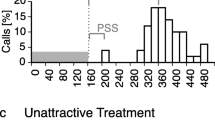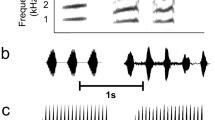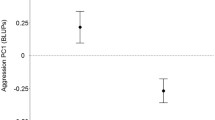Abstract
The attractiveness of an individual (i.e. its ability to arouse interest in a potential mate) has important implications for its reproductive success. However, attractiveness is not a fixed trait. Previous work has shown that male birds can adjust the intensity of their courtship display in response to variation in female behaviour, but little is known about how males adjust their behaviour during mate choice in response to social feedback about their own attractiveness independent of their intrinsic quality. Such information may help to maximize the potential mating success of males. Here, we provide experimental evidence that the amount of attention given by male zebra finches to females is dependent upon the manipulated attractiveness of males. This demonstrates that, in this socially monogamous species of bird, attractiveness of males could be considered to be a social construct, at least partially determined via social feedback from females.


Similar content being viewed by others
References
Burley NT, Foster VS (2006) Variation in female choice of mates: condition influences selectivity. Anim Behav 72:713–719
Burley N, Krantzberg G, Radman P (1982) Influence of colour-banding on the conspecific preferences of zebra finches. Anim Behav 30:444–455
Buston PM, Emlen ST (2003) Cognitive processes underlying human mate choice: the relationship between self-perception and mate preference in Western society. Proc Natl Acad Sci USA 100:8805–8810
Campbell DLM, Hauber ME (2009) The disassociation of visual and acoustic conspecific cues decreases discrimination by female zebra finches (Taeniopygia guttata). J Comp Psychol 123:310–315
Clayton NS (1990) Mate choice and pair formation in Timor and Australian mainland zebra finches. Anim Behav 39:474–480
Collins SA (1994) Male displays: cause or effect of female preference? Anim Behav 48:371–375
Collins SA (1995) The effect of recent experience on female choice in zebra finches. Anim Behav 49:479–486
Crawley MJ (2002) Statistical computing. Wiley, New York
Cuthill IC, Hunt S, Cleary C, Clark C (1997) Colour bands, dominance, and body mass regulation in male zebra finches (Taeniopygia guttata). Proc R Soc Lond B 264:1093–1099
Emery NJ, Seed AJ, von Bayern AMP, Clayton NS (2007) Cognitive adaptations of social bonding in birds. Phil Trans R Soc B 362:489–505
Forstmeier W, Birkhead TR (2004) Repeatability of mate choice in the zebra finch: consistency within and among females. Anim Behav 68:1017–1028
Godin J-GJ, Briggs SE (1996) Female mate choice under predation risk in the guppy. Anim Behav 51:117–130
Gong A, Gibson RM (1996) Reversal of a female preference after visual exposure to a predator in the guppy, Poecilia reticulata. Anim Behav 52:1007–1015
Hauber ME, Sherman PW (2001) Self-referent phenotype matching: theoretical considerations and empirical evidence. Trends Neurosci 24:609–616
Hauber ME, Sherman PW, Paprika D (2000) Self-referent phenotype matching in a brood parasite: the armpit effect in brown-headed cowbirds (Molothrus ater). Anim Cogn 3:113–117
Houston AI, McNamara JM (2002) A self-consistent approach to paternity and parental effort. Phil Trans R Soc B 357:351–362
Hsu Y, Wolf LL (2001) The winner and loser effect: what fighting behaviours are influenced? Anim Behav 61:777–786
Hughes KA, Du L, Rodd FH, Reznick DN (1999) Familiarity leads to female mate preference for novel males in the guppy, Poecilia reticulata. Anim Behav 58:907–916
Jirotkul M (1999) Operational sex ratio influences female preference and male–male competition in guppies. Anim Behav 58:287–294
Johnson JB, Basolo AL (2003) Predator exposure alters female mate choice in the green swordtail. Behav Ecol 14:619–625
Kokko H, Brooks R, Jennions MD, Morley J (2003) The evolution of mate choice and mating biases. Proc R Soc Lond B 270:653–664
Little AC, Burt DM, Penton-Voak IS, Perrett DI (2001) Self-perceived attractiveness influences human female preferences for sexual dimorphism and symmetry in male faces. Proc R Soc Lond B 268:39–44
Pariser EC, Mariette MM, Griffith SC (2010) Artificial ornaments manipulate intrinsic male quality in wild caught zebra finches (Taeniopygia guttata). Behav Ecol 21:264–269
Patricelli GL, Albert J, Uy C, Walsh G, Borgia G (2002) Male displays adjusted to female’s response. Nature 415:279–280
Riebel K (2003) Developmental influences on auditory perception in female zebra finches—is there a sensitive phase for song preference learning? Anim Biol 53:73–87
Reynolds JD, Gross MR, Coombs MJ (1993) Environmental conditions and male morphology determine alternative mating behavior in Trinidadian guppies. Anim Behav 45:145–152
Royle NJ, Hartley IR, Parker GA (2002) Sexual conflict reduces offspring fitness in zebra finches. Nature 416:733–736
Royle NJ, Lindström J, Metcalfe NB (2008) Context-dependent mate choice in relation to social composition in green swordtails Xiphophorus helleri. Behav Ecol 19:998–1005
Rutstein AN, Brazill-Boast J, Griffith SC (2007) Evaluating mate choice in the zebra finch. Anim Behav 74:1277–1284
Safran RJ, Neuman CR, McGraw KJ, Lovette IJ (2005) Dynamic paternity allocation as a function of male plumage color in barn swallows. Science 309:2210–2212
Safran RJ, Adelman JS, McGraw KJ, Hau M (2008) Sexual signal exaggeration affects physiological state in male barn swallows. Curr Biol 18:R461–R462
Schielzeth H, Burgera C, Bolundaand E, Forstmeier W (2008) Assortative versus disassortative mating preferences of female zebra finches based on self-referent phenotype matching. Anim Behav 76:1927–1934
Senar JC, Domènech J, Camerino M (2005) Female siskins choose mates by the size of the yellow wing stripe. Behav Ecol Sociobiol 57:465–469
ten Cate C, Mug G (1984) The development of mate choice in zebra finch females. Behaviour 90:125–150
Todd PM, Penke L, Fasolo B, Lenton AP (2007) Different cognitive processes underlie human mate choices and mate preferences. Proc Natl Acad Sci USA 104:15011–15016
Wachtmeister C-A (2001) Display in monogamous pairs: a review of empirical data and evolutionary explanations. Anim Behav 61:861–868
Welch AM (2003) Genetic benefits of a female mating preference in gray tree frogs are context-dependent. Evolution 57:883–893
Witte K (2006) The time spent with a male is a good indicator of mate preference in female zebra finches. Ethol Ecol Evol 18:195–204
Wong RY, Hopkins CD (2007) Electrical and behavioral courtship displays in the mormyrid fish Brienomyrus brachyistius. J Exp Biol 210:2244–2252
Wynn SE, Price T (1993) Male and female mate choice in zebra finches. Auk 110:635–638
Acknowledgements
NJR was supported by the Natural Environment Research Council on fellowship NE/C002199/1 and TWP by the Natural Environment Research Council on grant NER/A/S/2003/00490 to Jan Lindström, Neil Metcalfe and Jon Blount.
Author information
Authors and Affiliations
Corresponding author
Additional information
Communicated by M. Hauber
Rights and permissions
About this article
Cite this article
Royle, N.J., Pike, T.W. Social feedback and attractiveness in zebra finches. Behav Ecol Sociobiol 64, 2015–2020 (2010). https://doi.org/10.1007/s00265-010-1013-1
Received:
Revised:
Accepted:
Published:
Issue Date:
DOI: https://doi.org/10.1007/s00265-010-1013-1




